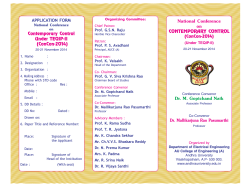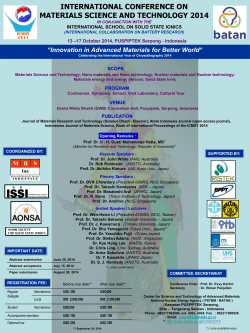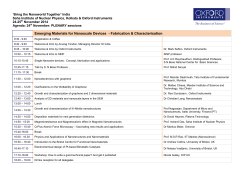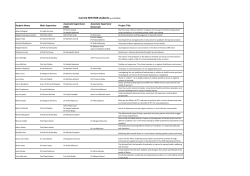
Japan as a knowledge economy - Assessment and lessons for developing countries-
May, 2006 Japan as a knowledge economy - Assessment and lessons for developing countriesJJ/WBGSP Scaling Up African Conference In Nairobi, Kenya Tsutomu Shibata Senior Adviser, World Bank Institute tshibata@worldbank.org Why focus on knowledge Economy now? •A “knowledge revolution”! Reflected in the speed-up in creation and dissemination of knowledge. •Opening up opportunities for leapfrogging, but also raising risks that developing countries may fall behind •All countries need to develop explicit strategies to take advantage of this new knowledge to avoid being left behind. •Many definitions of the “Knowledge Economy”:most focus only on IT and high technology sectors 2 A broader definition of Knowledge Economy: “An economy that creates, acquires, adapts, and uses knowledge effectively for its economic and social development.” 3 The Four Pillars of the Knowledge Economy Economic and Institutional Regime Information Infrastructure Education Job Training Innovation 4 WBI Knowledge for Development 5 KAM Score Card: Japan and Kenya 6 Knowledge Assessment methodology (KAM) • Based on the four Knowledge economy pillars. • 80 structural/qualitative variables. • 128 countries. • Benchmarks performance for two points in time: 1995 and most recent year. • Basic (simplified) scorecard for 14 key variables. • Aggregate knowledge economy index (KEI), ranging from 0 (weakest) to 10 (strongest). www1.worldbank.org/gdln/kam.htm 7 Outline Japan, Moving Toward a More Advanced Knowledge Eonomy Volume 1: Assessment and Lessons Volume 2: Advanced Knowledge Creating Companies (Hitotsubashi ICS) 8 Volume I : 4 Pillars Chapter 1: Introduction (Tsutomu Shibata ,WB ) Chapter 2: Japan’s Development and Growth Process (Prof. Miyajima, Waseda) Chapter 3 : The Competitiveness of Japanese Industries and Firms (Prof. Takeuchi, Hitotsubashi) Chapter 4 : Elements of a New Economic and Institutional Regime for an Advanced Knowledge Economy (Tatsuji Hayakawa, WB) Chapter 5 : Information Infrastructure (Mr. Nezu, Fujitsu Soken ) Chapter 6: The IT Revolution’s Implications for the Japanese Economy (Prof. Motohashi, University of Tokyo) Chapter 7: Education, Training, and Human Resources: Meeting Skill Requirements (Prof. Yonezawa, Univ Evaluation & Research, National Institute for Academic Degrees, and Ms. Kosugi, the Japan Institute for Labor Policy and Training) Chapter 8: National Innovation System: Reforms to Promote Science-Based Industries (Prof. Odagiri, Hitotsubashi) Chapter 9: Moving Toward a More Advanced Knowledge Economy: Lessons and Implications (Tsutomu Shibata WB ) 9 Volume II (Industries &Firms) Chapter 1. Chapter 2. Chapter 3. Chapter 4. Chapter 5. Chapter 6. Chapter 7. The New Dynamism of the Knowledge-Creating Company (Prof. Takeuchi) Knowledge Creation in the Convenience Store Industry: Seven-Eleven Japan (Prof. Ikujiro Nonaka) Learning and the Self-Renewing, Network Organization:Toyota and Lexus Dealers (Prof. Emi Osono) Strategic Management of Knowledge-Based Competence: Sharp Corporation (Prof. Kazuo Ichijo) Invisible Dimensions of Differentiation: Japanese Electronics Companies (Prof. Ken Kusunoki) Inter-Organizational Knowledge Creation at Shimano (Prof. Takeuchi) Creating the Dynamics of Hard-to-Imitate Innovation (Prof. Takeuchi) 10 Why Japan? Why Japan now? 1. 2. 3. The tremendous speed and resilience Japanese industries had shown in catching up with the industrial world and overcoming the oil and Yen shocks. Japan still has many strong leaders in some industries due to the advanced manufacturing process despite the overall decline of its competitiveness. Imbalance between these strong industries/companies and weak industries. 12 Japan’s Competitiveness IMD Ranking 1989 1 1993 1 2004 23 2005 21 Is this right evaluation? 13 Japan’s Competitiveness Ranking 1989 1 1993 1 profit ratio* 6.1% 2.7% ROE 8.5% 1.7% *Operational profit ratio for 691 firms 14 % Shares of World GDP - Constant US$ (1960 - 2002) 40 High income: OECD ex. US & Japan 35 Sub-Saharan Africa 30 United States 25 High Income: Non-OECD (Black) 20 Japan Middle East & North Africa (Light Blue) South Asia Europe & Central Asia (Grey) 15 10 Latin American & Caribbean East Asia & Pacific 5 0 1960 1965 1970 1975 1980 1985 1990 1995 2000 15 16 17 18 19 年 20 21 Japan’s National Innovation System Technology Imported* Final products => ‘reverse engineering’ Components => at first imported for knockdown, then substituted by domestic production Equipment and tools => often remodeled Licensing *Model for Japan/Korea/Taiwan (VS Thai/Malaysia) 23 The Role of Government Education: (the school system + willingness to learn) Infrastructure: e.g., transportation and communication, also commercial code, patent, and other legal systems. Research: national research institutes, and universities Protection against foreign competitors (NO FDI) Subsidies and tax concession Gov fund in R&D—not large (20% -2000, US 28%) 24 The Traditional Japanese Business System Friendly shareholders and internally-promoted managers. Pursuit of long-run goals. Long-term employment with internal training and rotation. Long-term assembler-supplier relationship Sharing of information, joint R&D. Flexibility in rearranging workshops and the nurture of workers’ broad skills. Easier introduction of new technologies. 25 Changing Business Environment Weakening of stable shareholders Occurrence of hostile M&As Occurrence of bankruptcy and worker dismissal IT Revolution Loss of production skills, caused by the overseas shift of production 26 Changing Economic Situations End of catch-up Strict enforcement of intellectual property rights by foreign companies => Difficulty in acquiring overseas technologies Depressed demand since 1990 Prolonged Financial Sector Problems Declining rate of new business establishment 5.8% (1975-78) to 3.1% (1999-2001) Now, lower than the exit rate (4.5%) 27 Need to Advance Science-Based Industries Development is pursued with innovations based on sciences Industrializing the outcome of scientific research Applying sciences to solve bottlenecks in R&D and production 28 Important Features of ScienceBased Industries Science linkages (Increasing citation of scientific papers in US patents) Intellectual property rights (returns for inventors ) Diversity and change in the Boundary of the Firm (cannot perform R&D alone) University-industry Inter-firm alliances collaborations Widespread use of the technology across industries 29 University-Industry (UI) Collaboration Encouragement of UI joint research Tax concessions granted to company R&D for UI Universities facilities for UI joint research / startups’ rent Encouragement of university spin-offs New startups: 11 in 1995 to 135 in 2002 (now 600, much less than in US) Patent fees are reduced for university inventions Technology licensing offices (TLOs) were established to promote patenting and licensing No. increased (national universities): 1139 in 1990 => 4029 in 2000 36 TLOs as of end 2003 Deregulation on professors’ assuming company directorship 280 professors (of national universities) allowed to become directors or auditors of companies (as of 9/03) 30 Promotion of Startups The Law for Facilitating the Creation of New Business, 1999 Subsidies and guarantees for SMEs to start new businesses and to develop and commercialize new technologies. Tax advantages (‘the Angel Tax’) Reduction of minimum capital for a new stock company: 1 million yen => 1 yen Stock options as a compensation scheme 31 Increasing High-Tech Startups Increase in biotechnology startups 60 in 1998 => 387 in 2003 Increase in IPOs About 100 such IPOs in 2003 in three markets 32 Issues of Recruitment Two main barriers to start new firms Financing (Many VC were established) Recruitment of staff Difficulty in recruitment is deep-rooted because of the Japanese employment system Many talents are in big firms Long-term worker-company attachment Still, a number of conspicuous cases have started to appear 33 Japan’s Education/Job Training Systems Overview of Japan’s Education System 90% completion of K12 since mid 1970s. 70% of secondary education graduates go to higher education. Large private higher education and hierarchy based on selectivity. Strong in engineering and technology education/research. Extraordinary low dropout rate of higher edu. Historical negligence of academic achievement at the output level (Diploma Disease.) Postgraduate education popular in natural sciences and engineering, not in social sciences, business, law study. Establishment of professional school system (law, business) as new trials. 35 Traditional career development in LT employment University names had critical influences on the initial entrance to labor market. Personnel division controls human resource allocation and career mobility within firms. Different labor markets for large enterprises and for SMEs. Stress on ‘trainability’ (general skill) at recruitment, and strong tradition of company specific skills, tacit skills, OJT, Seniority, etc. Strong knowledge/skill infrastructure based on the national language. 36 Inconsistency between Macro and Micro Perspectives On a macro perspective, it clearly demands strong education/training system. Global competition in average academic achievement. World leaders and qualified professionals English education in early stage. On a micro perspective, it demands stable and protected life. Low incentives for study in schools. Excess supply of education. Good education background no longer assures life time employment. Preference of freelance position rather than fulltime position. Emergency of aging society. 37 CONCLUSION Economic Regime-Related Lessons and Implications Better supervision of the financial sector and more accurate disclosure of NPLs. Corporate governance matters. Shareholders, rating agencies, and bond/equity analysts are important. Inward FDI must accompany substantial efforts to develop the capacity to absorb it. 39 Labor-Related Lessons and Recommendations Higher mobility and flexibility in the labor market based on more lifetime learning and re-entry, especially for women. Increase of value-added per worker through innovation is crucial for an aging and decreasing population. 40 IT-Related Lessons and Implications IT investment must be accompanied by proper changes in organization and work practice. Speed, selection, concentration, and collaboration are core for IT strategy. To achieve speed, firms must concentrate on core competencies. Firms with complementary core competencies can profit from collaborating to achieve innovation quicker than doing everything inhouse. 41 Human-Resource-Related Lessons and Implications Literacy and general education are key factors for development. Capacity development can be enhanced by company-provided training and voluntary initiatives by workers. Education/training systems must facilitate changing jobs without disadvantages, and also re-entry into the labor market. Globalization and the IT revolution require continuous adjustment in the business skills and educational/training systems. 42 Innovation-Related Lessons and Recommendations Domestic R&D and education are crucial to make imported technologies applicable to manufacturing processes. A proper competitive environment to promote R&D is needed to use imported technology fully. R&D funding by the gov’ needs to be prioritized and wellcoordinated among ministries. The US National Institutes of Health can be a model. Closer collaboration between universities and industries is needed in patent licensing and commissioned/ joint research. Venture business should be promoted with appropriate incentives including an "angel tax system" (favorable tax treatment for investors.) Creation of a support system for entrepreneurs, consultants, accountants, and lawyers familiar with advanced technology and IPR should be encouraged. 43
© Copyright 2025





















